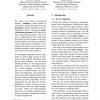Free Online Productivity Tools
i2Speak
i2Symbol
i2OCR
iTex2Img
iWeb2Print
iWeb2Shot
i2Type
iPdf2Split
iPdf2Merge
i2Bopomofo
i2Arabic
i2Style
i2Image
i2PDF
iLatex2Rtf
Sci2ools
EMNLP
2009
2009
Parser Adaptation and Projection with Quasi-Synchronous Grammar Features
We connect two scenarios in structured learning: adapting a parser trained on one corpus to another annotation style, and projecting syntactic annotations from one language to another. We propose quasisynchronous grammar (QG) features for these structured learning tasks. That is, we score a aligned pair of source and target trees based on local features of the trees and the alignment. Our quasi-synchronous model assigns positive probability to any alignment of any trees, in contrast to a synchronous grammar, which would insist on some form of structural parallelism. In monolingual dependency parser adaptation, we achieve high accuracy in translating among multiple annotation styles for the same sentence. On the more difficult problem of cross-lingual parser projection, we learn a dependency parser for a target language by using bilingual text, an English parser, and automatic word alignments. Our experiments show that unsupervised QG projection improves on parses trained using only hi...
| Added | 17 Feb 2011 |
| Updated | 17 Feb 2011 |
| Type | Journal |
| Year | 2009 |
| Where | EMNLP |
| Authors | David A. Smith, Jason Eisner |
Comments (0)

